Administrative Region : North Aegean
Regional unit : Chios
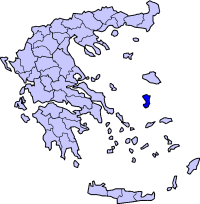
|
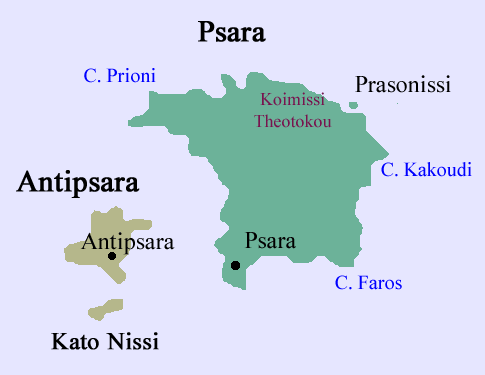 |
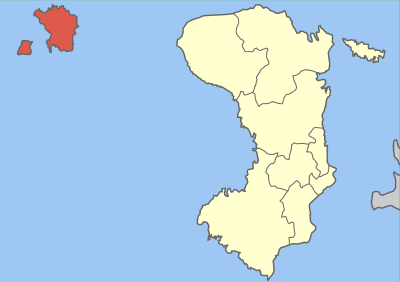
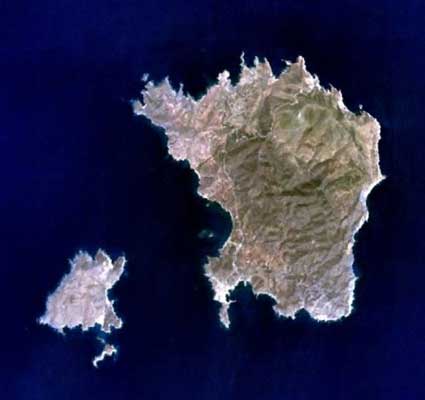
Psara, NGA
Psara (Greek: Ψαρά, Psará, Greek pronunciation: [psaˈra]; formerly known as Ψύρα, Psyra, or Ψυρίη, Psyriī) is a Greek island in the Aegean Sea. Together with the small uninhabited island of Antipsara it forms the municipality of Psara. It is part of the Chios peripheral unit, which is part of the North Aegean Periphery. The only town of the island and seat of the municipality is also called Psara.[1]
Psara had 448 inhabitants according to the 2011 census. It has a small port linking to the island of Chios and other parts of Greece.
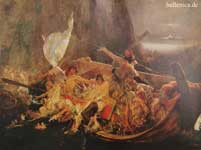
After the Destruction of Psara, Nikolaos Gyzis
Geography
Psara lies 44 nautical miles (81 km) northwest of Chios, 22 km (about 13 nmi) from the northwestern point of the island of Chios and 150 km (about 75 nmi) eastnortheast of Athens. The length and width is about 7 x 8 km and the area of the island is 43 km². The highest point of the island is "Profitis Ilias" (512 metres (1,680 ft)).
Flag
Flag of Psara during the Greek War of Independence.
The flag of Psara was designed by the Psariots[2] and bears symbols of Filiki Eteria.[3][4] It is made of white cloth bordered with red with a large red cross and the inscriptions of the name of the island "ΨΑ-ΡΑ" and the words Eleftheria i Thanatos (Liberty or Death) in capital red letters. The cross is standing on an upside down crescent, flanked on one side by a sword, on the other by a serpent killed by a bird.[2][4] The flag was carried during the War of Independence by Psariot ships[5]
An original flag of Psara, is preserved at the National Historical Museum of Greece[3]
History
It has been inhabited since the Mycenaean period, its inhabitants relying on the sea to make a living as the island is a treeless and rocky with little shrubbery. Homer first referred to the island as Psyra.[6][7]
The islanders' sole source of livelihood has always been fishing, mainly for the locally abundant slipper lobsters, and shipping, with some tourist development in recent years.
Destruction of Psara
Main article: Destruction of Psara
After the destruction of Psara by Nikolaos Gyzis.
Psara joined the Greek War of Independence on April 10, 1821. A noted native naval leader of the time was future Prime Minister of Greece Constantine Kanaris. The island was invaded on June 21, 1824 by Egyptian forces under the command of Ibrahim Pasha.
On July 4 the resistance of the Psariots ended with a last stand at the town's old fort of Palaiokastro.[2] Hundreds of soldiers and also women and children had taken refuge there when a Turkish force of 2000 stormed the fort. The refugees first threw a white flag[8] with the words "Ελευθερία ή Θάνατος" ("Eleftheria i Thanatos", "Freedom or Death". Then, the moment the Turks entered the fort, the local Antonios Vratsanos lit a fuse to the gunpowder stock, in an explosion that killed the towners along with the their enemies — thus remaining faithful to their flag to their death.[2] A French officer who heard and saw the explosion compared it to a volcanic eruption of Vesuvius.[2]
A part of the population managed to flee the island, but those who didn't were either sold into slavery or killed. As a result of the invasion, thousands of Greeks have met a tragic fate. The island was deserted and surviving islanders were scattered through what is now Southern Greece. Theophilos Kairis, a priest and scholar, took on many of the orphaned children and developed the famous school the Orphanotropheio of Theophilos Kairis.
The tragic event of the destruction of Psara inspired the poet Dionysios Solomos — the author of the Hymn to Liberty — to write a poem about it called "The Destruction of Psara".[9]
Bronze medal of 1824 commemorating the holocaust of Psara.ΕΛΕΥΘΕΡΙΑ Η' ΘΑΝΑΤΟΣ,ΟΛΟΚΑΥΤΩΜΑ ΨΑΡΡΩΝ - 24 ΙΟΥΝΙΟΥ 1824 (FREEDOM OR DEATH,HOLOCAUST OF PSARA - 24 JUNE 1824).
“
On the all-black ridge of Psara
Glory walks by herself taking in
the bright young men on the war field
the crown of her hair wound
from the last few grasses left
on the desolate earth
”
Historical population
Year Population
1824 7,000[10]
1981 460
1991 438
2001 422
Notable people
Constantine Kanaris.
Constantine Kanaris (1793/1795-1877) admiral, freedom fighter and politician, Prime Minister of Greece
See also
Communities of the Chios prefecture
References
^ Kallikratis law Greece Ministry of Interior (Greek)
^ a b c d e CONGRESSIONAL RECORD—HOUSE March 24, 1995
^ a b Flag of Psara, Revolution of 1821 -National History Museum Catalogue Number: 1752
^ a b Nations and States in Southeast Europe,Center for Democracy and Reconciliation in South Eastern Europe. p.99
^ "Η Ελληνική Σημάια", (The Greek flag) - Hellenic Army General Staff, Page 11, Image 14:[1]
^ Homer, Odyssey, III http://classics.mit.edu/Homer/odyssey.3.iii.html
^ Agelarakis A., "Report on the Main Burial of the Mycenaean Human Skeletal Remains excavated from Archontiki Site, Psara, Greece", OSSA 13 (1986-87): 3-11.
^ Typos, Cyprus newspaper
^ Jerome Rothenberg, Jeffrey Robinson (2009). Poems for the Millennium, Volume Three. University of California Press. p. 358. ISBN 9780520255982.
^ Finlay, George. History of the Greek Revolution and the Reign of King Otho (edited by H.F. Tozer). Oxford: Clarendon Press, 1877 (Reprint: London 1971), ISBN 900834129, p. 152.
Greece :
A - B - C - D - E - F - G - H - I - J - K - L - M -
N - O - P - Q - R - S - T - U - V - W - X - Y - Z
All text is available under the terms of the GNU Free Documentation License
| Ancient Greece
Science, Technology , Medicine , Warfare, , Biographies , Life , Cities/Places/Maps , Arts , Literature , Philosophy ,Olympics, Mythology , History , Images Medieval Greece / Byzantine Empire Science, Technology, Arts, , Warfare , Literature, Biographies, Icons, History Modern Greece Cities, Islands, Regions, Fauna/Flora ,Biographies , History , Warfare, Science/Technology, Literature, Music , Arts , Film/Actors , Sport , Fashion --- |

